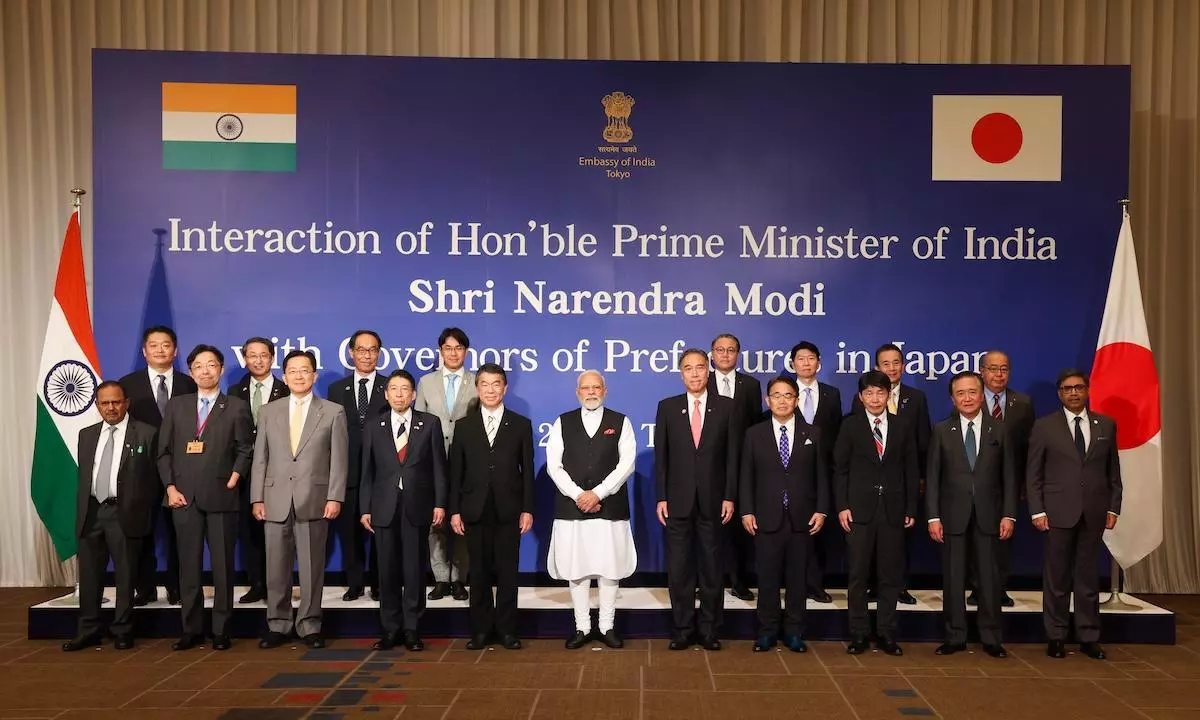
Modi meets 16 Japanese governors, invites them to contribute to India’s growth story
There is immense scope to cooperate in areas like trade, innovation, entrepreneurship and more, Modi says in Japan

Prime Minister Narendra Modi, who is on a two-day visit to Japan, met governors of 16 Japanese prefectures in Tokyo on Saturday (August 30).
In the meeting, he called for forging state-prefecture cooperation under the India-Japan Special Strategic and Global Partnership, the Ministry of External Affairs (MEA) said in a statement. In Japan, prefectures are administrative divisions similar to provinces and states in other countries.
“This morning in Tokyo, interacted with the governors of 16 prefectures of Japan. State-prefecture cooperation is a vital pillar of India-Japan friendship. This is also why a separate initiative on it was launched during the 15th Annual India-Japan Summit yesterday,” the Prime Minister said in a post on X.
“There is immense scope to cooperate in areas like trade, innovation, entrepreneurship and more. Futuristic sectors like Startups, tech and AI, too, can be beneficial,” he added.
Also Read: PM Modi arrives in Japan, to visit China next: What’s on agenda?
The MEA also shared details of the interaction in a post on X, saying, “Taking greater strides in the steadfast India-Japan ties. PM Narendra Modi met with the Governors of 16 prefectures in Tokyo.”
Discussions focused on ways to further deepen the growing partnerships between Indian states and Japanese prefectures in the fields of technology, innovation, investment, skills, start-ups and SMEs, the ministry added.
Also Read: Indian economy prepares for long haul as Trump tariff strikes home
Focus on youth, skills
Noting that each Japanese prefecture has its own economic and technological strengths and Indian states their unique capabilities, the Prime Minister invited the Japanese governors to contribute to India’s growth story. He also called for joint efforts in youth and skills exchange and optimally combining Japanese technology with Indian talent, the MEA said.
He highlighted that the State-Prefecture Partnership Initiative would boost cooperation in trade, technology, tourism, skills, security and cultural exchanges.
The governors observed that sub-national collaboration was key to taking bilateral business, educational, cultural and people-to-people ties to the next level, it added.
Modi stresses stable India-China ties
Speaking to the media in Japan on Friday (August 28), Modi stressed that strong relations with China are “crucial”, stating that it will have a “positive impact on regional peace and prosperity”, and could bring stability to the global economy.
Also Read: Modi at SCO 2025: Five key things to watch in Tianjin
After completing his two-day visit to Japan, Modi is set to travel to China for the Shanghai Cooperation Organisation (SCO) summit. The regional grouping also includes Russia, Iran, Kazakhstan, Kyrgyzstan, Pakistan, Tajikistan, Uzbekistan, and Belarus.
“At the invitation of President Xi Jinping, I will travel from here to Tianjin to participate in the SCO summit. Since my meeting with President Xi in Kazan (Russia, during last year’s SCO summit), our bilateral relationship has witnessed steady and positive progress,” Modi told Japanese media.
“Stable, predictable, and amicable bilateral relations between India and China, the two largest nations on Earth, can have a positive impact on regional and global peace and prosperity. This is also vital for a multipolar Asia and world.”
His comments echoed earlier remarks following a meeting with Chinese Foreign Minister Wang Yi in Delhi this month.
Thaw in bilateral relations
The SCO summit comes at a time when India is grappling with global economic and geopolitical turbulence, driven by Russia’s war in Ukraine, Israel’s war in Gaza, and the United States’ imposition of a 50 per cent tariff on Indian exports.
The US tariff decision, in particular, has nudged India and China towards easing decades-long military tensions, as both countries look to recalibrate ties to mitigate potential economic setbacks.
Signs of this thaw appeared in March, after the US began taxing Chinese goods. Wang Yi had then urged Delhi and Beijing to “take the lead in opposing hegemonism and power politics,” famously remarking that "making the dragon and elephant dance is the only right choice."
Also Read: Stable India-China ties key to global peace, prosperity, says PM Modi
Partnership to boost stability
President Xi Jinping later echoed this metaphor, signalling Beijing’s seriousness about pursuing mutually beneficial relations with India. Reports suggest Xi even reached out personally.
In Japan, Modi acknowledged these sentiments, saying, "Given the volatility in the global economy, it is important for India and China to work together to bring stability to the world economic order. India is ready to advance bilateral relations from a strategic and long-term perspective on the basis of mutual interest."
One of those key areas of mutual interest is expected to be the Electric Vehicle (EV) sector, which relies heavily on rare earth minerals, an area where collaboration could prove crucial.
(With agency inputs)

